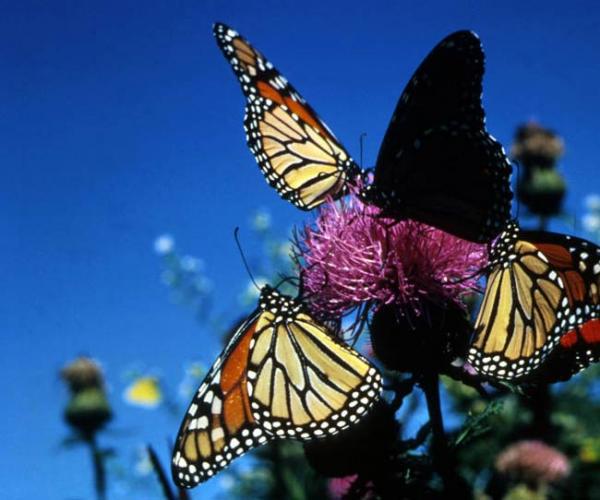Extreme Weather Strikes Blow to Monarch Butterflies


Monarch butterflies flying on their annual migration made an unexpected early entrance in many parts of the United States this year, prompting astonished squeals of joy among some butterfly enthusiasts.
"I was surprised they're here already!" wrote one butterfly watcher in Fairborn, Ohio, on April 14 on the monarch tracking site Journey North. [Related: Images of Incredible Animal Migrations ]
Not everyone views the colorful surprise with such glee. The early trickle may signal dark times ahead for this already beleaguered species.
Monarch populations have faced declines in recent years, hit hard by extreme weather and habitat loss at their overwintering sites in Mexico, and a steep reduction in milkweed across North America, the only plant upon which the butterflies lay their eggs.
The record-breaking spring droughts and rains on this side of the border are adding to their woes.
"The scenario is not good. The butterflies moved too far north too fast," said Chip Taylor, a professor and insect ecologist at the University of Kansas, and the director of Monarch Watch, a nonprofit outreach organization.
"We've got two strikes against us right now," Taylor said, pointing to hot, dry weather in Texas and cold, wet weather everywhere else.
Get the world’s most fascinating discoveries delivered straight to your inbox.
The problem lies in the time it takes monarchs to hatch. In ideal conditions — those of a dry Texas spring — a monarch goes from egg to adulthood in about 26 days.
With the butterflies wandering so far north because of the extreme Texas weather, to an area in the grip of the wettest April on record — one that has been responsible for much of the Mississippi flooding now devastating many parts of the United States — it could take as long as 40 or 45 days for monarchs to reach maturity, Taylor told OurAmazingPlanet.
"If it's wet, it tends to be cooler, and that tends to slow things down," Taylor said, which will, in effect, strike a blow to the overall monarch population.
Monarch mamas
To understand why, one must think about not only the birth rate, but the time when offspring are born. It turns out that for monarchs, being a young grandmother is a good thing.
Taylor said human reproduction can provide a good illustration. If a woman has all her babies at a young age, she will contribute to the overall population more than a woman who has the same number of babies, but at an older age, and spread out over many years.
If a woman has three children, a child a year beginning when she's 18, those children will, in theory, be able to reproduce in short order.
Contrast that with another woman who also has three children, but waits until she's 28, then again until age 34, then gives birth to her last child at age 40. Those three children won't be adding to the population as soon as the children birthed by woman number one.
This year, the monarchs are stuck in scenario number two, spreading their eggs over a vast area, where they won't hatch as early.
Texas troubles
The dire turn of events comes on the heels of a boom year for butterflies.
Thanks to favorable monarch breeding conditions in 2010, the population that returned to Mexico last fall was twice as large as the generation that left in the spring.
However, a scorching drought and strong winds in Texas meant the butterflies just kept on moving north this year, and in unprecedented numbers.
"If I had my druthers and I was a monarch butterfly, I'd lay all my eggs in Texas," Taylor said. "But they can't do that if conditions in Texas are terrible."
More monarchs appeared north of 36 degrees latitude this April than any year since record-keeping began.
"There's very little prospect at this point that the population will increase over last year's numbers," Taylor said.
In fact, Taylor said, the butterflies could be on track for their worst year ever, rivaling 2009 for a new low.
Monarchs retire to a pine forest in Mexico for the winter months, and during the 2009-2010 season, the butterflies covered a mere 206,670 square feet (19,200 square meters) of trees — an area only about one-eighth larger than the average Walmart Supercenter store.
- Quest for Survival — Incredible Animal Migrations
- In Images: Amazing Tropical Butterflies
- Top 10 Most Incredible Animal Journeys
Andrea Mustain is a staff writer for OurAmazingPlanet, a sister site to LiveScience. Reach her at amustain@techmedianetwork.com. Follow her on Twitter @AndreaMustain.


